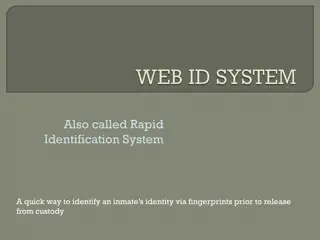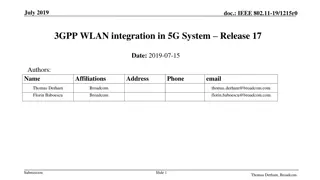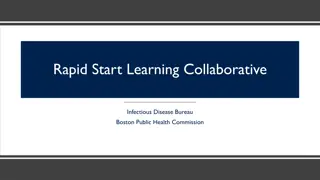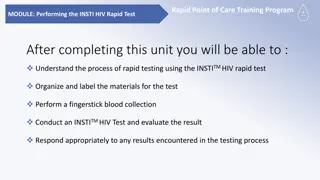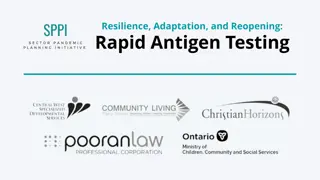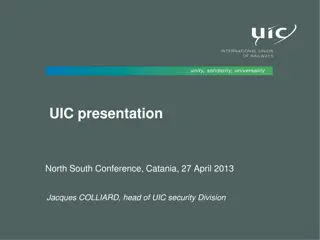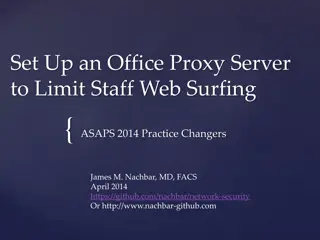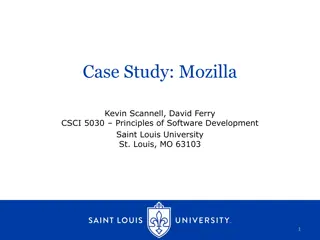Security and Rapid Release in Firefox
Explore how security and rapid release cycles impact software development in Firefox. Learn about integrating security into app development, related research on software quality, and goals for validating vulnerability impacts in Agile RRC development.
Uploaded on Sep 11, 2024 | 0 Views
Download Presentation

Please find below an Image/Link to download the presentation.
The content on the website is provided AS IS for your information and personal use only. It may not be sold, licensed, or shared on other websites without obtaining consent from the author.If you encounter any issues during the download, it is possible that the publisher has removed the file from their server.
You are allowed to download the files provided on this website for personal or commercial use, subject to the condition that they are used lawfully. All files are the property of their respective owners.
The content on the website is provided AS IS for your information and personal use only. It may not be sold, licensed, or shared on other websites without obtaining consent from the author.
E N D
Presentation Transcript
+ Moving Targets: Security and Rapid-Release in Firefox Presented by Carlos Bernal-C rdenas Presented by Carlos Bernal-C rdenas
To design, build, and deploy secure applications, [...] integrate security into your application development life cycle and adapt your current soft- ware engineering practices and methodologies to include specific security-related activities
+Related Work Software Development Woody et al. surveyed Agile developers about the impact of security engineering activities on software development using Agile approaches Seacord et al. notes that the traditional model of patching-and- install is problematic Bessey et al. discuss the prevailing attitudes towards software upgrades in terms of the number of bugs generated by each release
+Related Work Firefox Software Engineering Firefox has been the focus of prior research concerning software quality in its long history as open source project Khomh et al. evaluates the effect of rapid release model using different metrics as proposed in this paper Number bug after release Median daily crash count Median uptime Almossawi s work takes into account of the maintainability of Firefox since RRC version
+Related Work Lifecycle Issues Foundational work on vulnerabilities lifecycles concluded that Windows of vulnerabilities exist, during which software is more likely compromised Gopalakrishna and Spafford speculated that the increased rate of discovery of vulnerabilities was the result of a learning of time However, Ozment points out, this incorrectly assumes that a fixed number of users form the total are looking for vulnerabilities Clark et al. posited the existence of a grace period enjoyed by software immediately following its release
+Goals Validate whether the switch to Agile RRC development introduce large numbers of new vulnerabilities into software Identify the moment in which the code base are vulnerabilities being discovered Check if the number of vulnerabilities detected have increased since the switch to RRC
+ Motivation Related Work Contributions Outline Methodology Conclusion Quiz
+Contributions New data set of Firefox vulnerabilities Quantitative evidence of: Low rate of increase on vulnerabilities since Firefox RRC Major vulnerabilities are not in the new code Vulnerabilities are not disclosed until RRC version gets obsolete Observation that frequent releases might provide some protection Further supporting evidence for an exploit-free grace period provided by attacker s learning curve
+Methodology Assumptions With each addition of new code , a number of new software defects are also added New vulnerabilities are also introduces and will be discovered and disclosed The attackers are analyzing code bases searching for weaknesses in both old and new code
+Methodology Vulnerability Taxonomy Baseline Vulnerabilities Vulnerabilities that affect the original codebase on which RRC was based Regressive Vulnerabilities Vulnerabilities discovered and disclosed in code after the version in which it was introduced has been obsoleted by a more recent version New Vulnerabilities Vulnerabilities that affects the current version of code at the time the disclosure but that do not affect previous versions
+Methodology Why Firefox? Since the initial release in 2004 Firefox has been an open source project Firefox has a well maintained and frequently available bug database Frequent target of attackers Bug Bounty program Firefox has historical development in ESR and RRC approaches
+Methodology Data Collection 617 Bug IDs were issued from the inception of RRC and the time of writing of this paper Extraction of the code from the mercurial repository Include file extensions such as .c, .cc, .cpp, .css, .h, Look into the Firefox s Extended Support Reseases
+Methodology Limitations Unknown vulnerabilities make the date of any given vulnerability hard to obtain In this paper the authors uses the disclosure date as an approximation for the discovery date Since Firefox is a frequent attack target, Mozilla responds fast issuing inter-cycle point releases for critical vulnerabilities
+RRC Versus ESR RRC ESR Rapid release advances our mission in important ways. We get features and improvements to users faster. We get new APIs and standards out to web developers faster. Maintenance of each ESR, through point releases, is limited to high- risk/high-impact security vulnerabilities and in rare cases may also include off-schedule releases that address live security vulnerabilities.
+RRC Versus ESR What would we expect to see? RRC ESR Increase in the number of vulnerabilities Rapid release advances our mission in important ways. We get features and improvements to users faster. We get new APIs and standards out to web developers faster. Maintenance of each ESR, through point releases, is limited to high- risk/high-impact security vulnerabilities and in rare cases may also include off-schedule releases that address live security vulnerabilities. of vulnerabilities The scope of vulnerabilities should change Frequent changes should increase the rate
+Research Questions Does the addition of 250k+ LOC every 42 days markedly increase the number of vulnerabilities discovered and disclosed? 1. Is the scope of disclosed vulnerabilities confined to RRC? 2. Are the RRC vulnerabilities easier to find? 3.
+Conclusions Vulnerabilities are disclosed on the older code at least as often as they are in the newer code Firefox rapid-release cycles expose the software to a shorter window of vulnerability The authors study suggested that familiarity with a codebase is a useful heuristic for determining how quickly vulnerabilities will be discovered
+Quiz What are the 4 reasons the authors choose Firefox as subject in their study? What is the main focus of Agile approaches compare to models intended to produce secure systems? Why rapid-release cycles expose Firefox to a shorter window of vulnerabilities?
+ Questions











